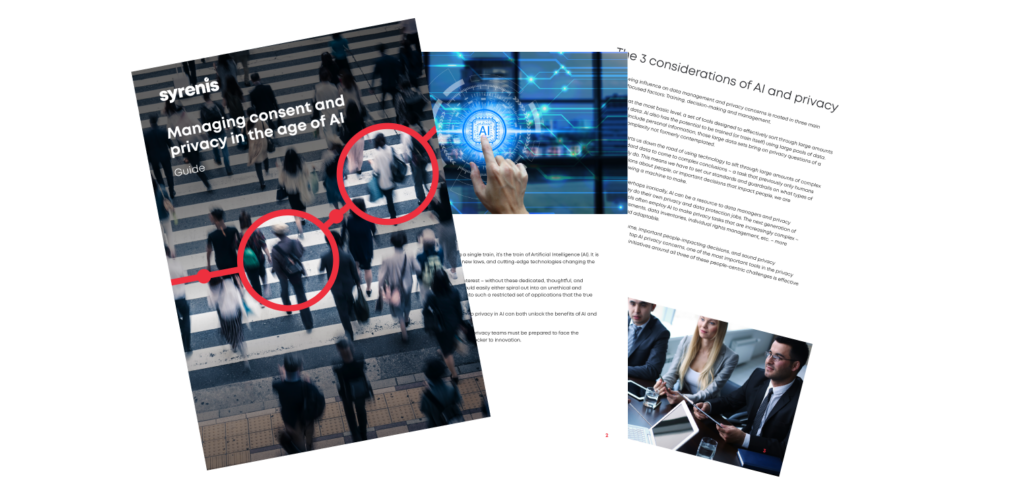What would it be like for a customer to interact with a company in precisely the way they want, see exactly the topics or products that interest them, automatically have their experience change as variables change (like shipping delays, price changes, and new product releases), and have their questions answered even before they ask them?
What would it be like for all of this to happen seamlessly, across multiple channels, and without additional, intense human effort (and costs)?
This is the world that Artificial Intelligence (AI) makes possible – not just in the future, but today.
Current AI technology can reliably review a complex set of circumstances and react. Triggered by customer requests or internal/external information, AI can implement different workflows, present different experiences and information, adjust processes, and communicate with customers based on preference data.
Imagine hyper-personalized experiences
Take a real-world example:
- A movie buff just bought a new, faster tablet device to stream old movies and uses that device to look for movie streaming services online.
- The potential customer visits one movie streaming website and sees an offer that includes a free tablet protective cover with a year subscription.
- The individual signs up on the spot and interacts with the company about the order and service through text messages, and they pay through a third-party payment processor.
- When the customer returns to the website the next day to stream a movie the first time, they see a video on first-time download instructions. They also see tracking information for their free gift, updated daily.
- Unfortunately, it looks like incoming weather will delay the package, so the company sends the customer a text message explaining the situation and offers a small discount on the next month’s service fee to compensate.
- The customer has trouble with streaming the following day and uses the customer support chat service to ask questions.
- The chat feature helps the customer identify and fix the issue, and the customer receives a follow-up text message confirming that everything is okay.
- The customer responds with high marks for customer support and additionally suggests that the company somehow highlight which movies have English subtitles available.
- The next time the customer visits the website, the subtitle description feature is active, and the customer sees a description of available subtitles for each movie. The site also customizes movie recommendations according to the customer’s previous downloads.
All of this (and more) can occur solely through AI. In this fictional but not theoretical sequence, AI identifies enough information about the customer to customize an attractive offer.
AI communicates across different channels in a consistent manner, predicts and addresses problems in advance, and adjusts processes to address unavoidable problems when they occur. AI also understands and responds to customer questions and customizes experiences that the customer is likely to desire. In the background, AI may also be running analytics to determine back-office efficiencies, which products are most popular, and desirable website design changes.
Leveraging customer preference data in tandem with AI
Despite AI’s power and significance to the customer experience and business efficiency, none of this is possible without granular and accurate consumer notice and consent.
For example, communication across channels, such as text messages, is typically not possible without at least implicit consent, with most jurisdictions requiring explicit consent.
The cookies and other online trackers that make customization possible also may require notice and consent. Clear notice and consent also head off the ‘creepy factor’ that can come with granular customization and turn customers away. Additionally, customers who believe that they are talking (or, more likely, chatting) with a human being but are really talking with AI can feel tricked and walk away from the experience. Clear notice and consent also help prevent this.
It may be useful to consider not only how AI can drive more efficient, customized end-to-end customer experiences, but also how a thoughtful and granular approach to transparency and consent enables this customization.
- Customer support – AI can drive not only automated but very customized chat functionality, but it can also generate email responses and trigger alternative processes to help prevent or remedy customer experience challenges. At a minimum, an organization will want to disclose when and how AI is involved in the support process. More likely, an organization will also want to provide the customer options in the form of consents and preferences related to AI communications, as well as AI’s data uses that help the system perform its functions.
- Communication consents and preferences – Customers, especially Generation Z and younger customers, often want to communicate with a company through multiple channels. This means that a company will need to collect and manage consents and preferences related to email, telephone, SMS, apps, and even social media communications.
- Online cookies and trackers – Deep customization in the online world often requires cookies and other trackers. Notice and consent for these functional and advertising cookies are experiences that customers expect, and many regulators require.
- Customization consents and preferences – Though many customers like and even expect companies to know who they are and customize interactions and experiences, some customers find that level of customization ‘creepy.’ Other customers like hyper-personalization but only when they understand and control it. This means that AI-driven customization must go hand in hand with detailed notice/consent/preference experiences.
- Integrations and data sharing – Today’s customers also expect a unified interface with other companies with which they also do business, such as financial services companies and payment processors. However, the data sharing required to provide this seamless experience requires transparency and consent.
There is no doubt that AI has the potential to make customer experiences more engaging, accessible, effective and efficient.
However, using AI in this way without an equal level of transparency, consent, and preference management will place the organization in a precarious position from a compliance, as well as a customer management perspective.
Fortunately, consent and preference management technologies make granular consent and preference management possible, allowing organizations to truly unleash the power of AI.


